SVMoA Blog
Esther Pearl Watson: On Art & the Power of Personal Influence
Ava Scanlan (Communications & PR Manager)
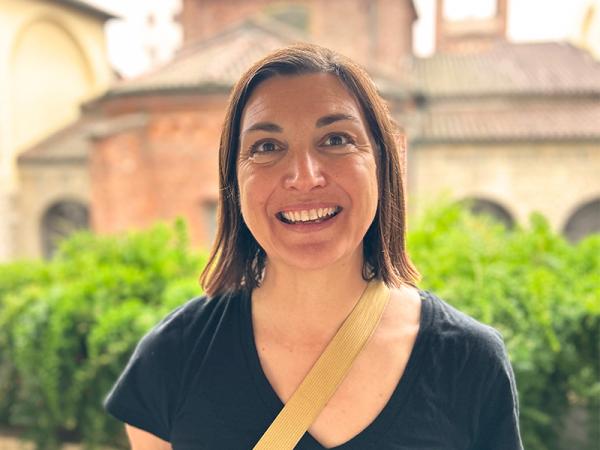
This week in SVMoA Voices, we sit down with Esther Pearl Watson, an artist based in Los Angeles currently teaching art at ArtCenter College of Design, who is in the group exhibition Sightings, on view through January 4, 2024, at the Sun Valley Museum of Art. Esther grew up in a series of small towns outside of Dallas, Texas, with her siblings, mother, and flying saucer-building father, Gene. Her father’s flying saucers and the nomadic aspects of her childhood inspire her “memory paintings,” which playfully narrate the experience of an economically precarious family living in rural America. Watson’s work highlights an absurd, persistent, and particularly American optimism that only seems to grow stronger in the face of failures of family, policy, and the American Dream.
You recently returned from your trip to Europe, how was that?
I went to visit my father and my aunt in Italy, outside of Milan. My father’s name was originally Gino Vescio; his adopted name is Watson. He was an orphan from postwar rural Calabria who was put on a plane to the United States after his grandparents heard the Pope on the radio saying, “Send your children to the United States, and they will have a better life.” So, they did. In some respects, he spent his adult life building a spaceship to go home. Since he returned to Italy in 1992, he stopped building large car-sized spaceships.
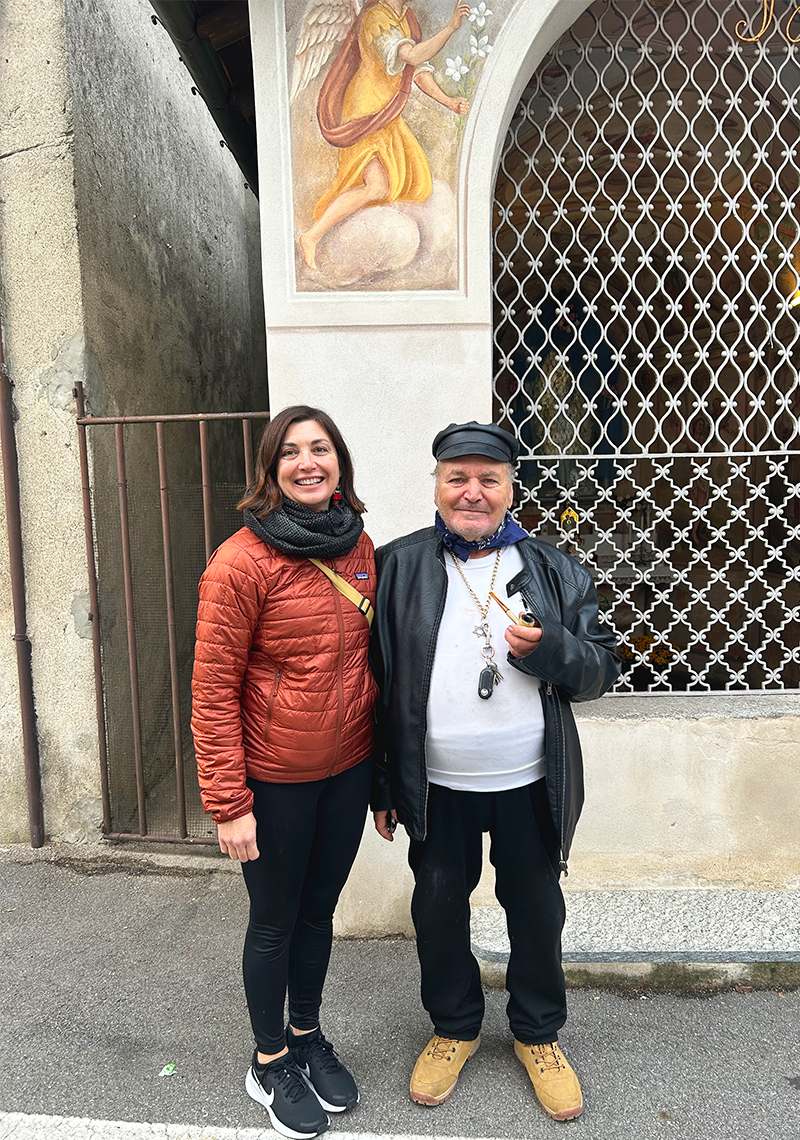
Esther Pearl Watson with her father standing beneath an angel. Her father believes angels guide him through the interstellar spaceship and show him how it works.
Italy played a large role in your upbringing. How did it influence you and your art?
When I was a child, my family, my mother and father and me and my four siblings, moved to Italy for two years. I was put in an Italian school and had to learn the language, which I remember learning very easily. I would often translate for my parents.
When I was 8-10 years old, I would go to mass at the tiny village church in Ferno, Italy. Italian was my second language, so during the mass, that was in Latin and Italian, I would look up at the paintings on the ceiling and make up stories to accompany what I saw. When we returned to the United States, my parents were always changing religions, and it often had to do with more where the food was than the religious beliefs. My mother was inter-denominational / Pentecostal, and my father Catholic.
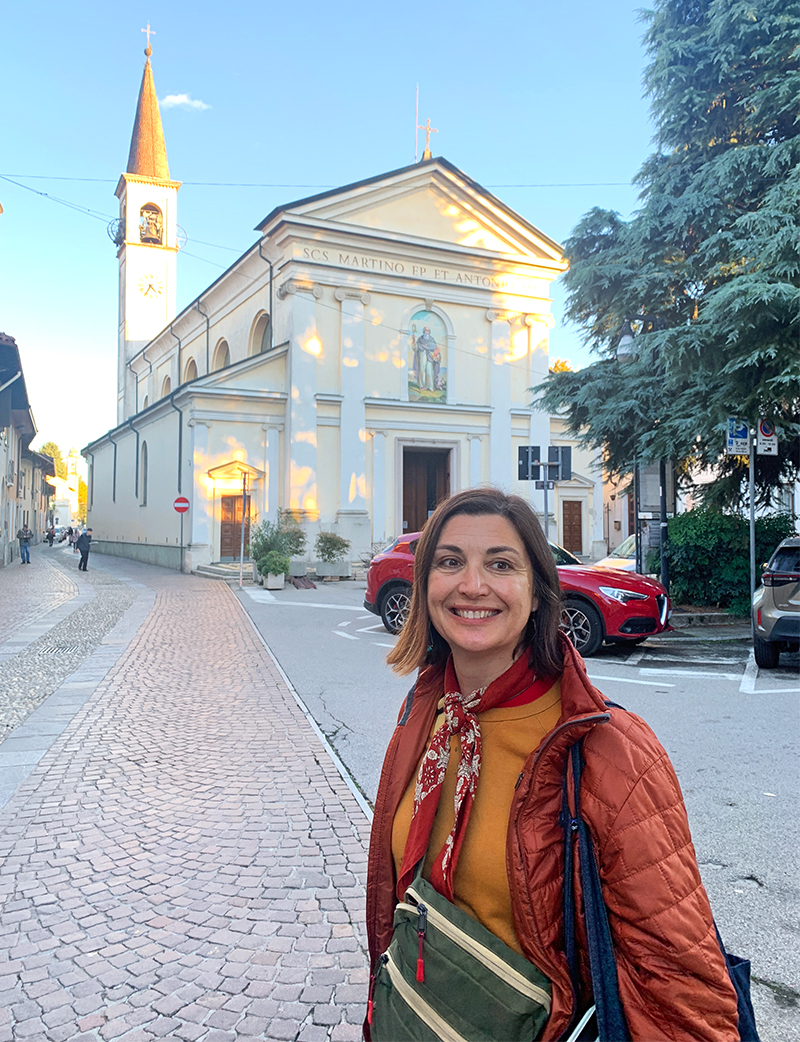
Esther Pearl Watson in from of her childhood church in Ferno.
You have compared your memory paintings to Ex Voto art, a form of folk art that traditionally acknowledges a tragic event intercepted by divine forces.
Yes, in college, I discovered Mexican Ex Voto art, which is very similar to Italian Ex Voto art, which are both a form of folk art. There is almost always a saint or a Virgin Mary floating in the sky, sometimes on a puffy cloud or surrounded by a glow. It’s a narrative where there is a beacon of hope. I realized later in life that the influence of Italy may have had something to do with that as well.
Also, it was also in college when I began to associate flying saucers as a kind of folk art. My big A-Ha moment was when I was in college and I discovered Douglas Curran’s book In Advance of the Landing: Folk Concepts of Outer Space, a book on photography of people believing in and building spaceships. When I saw those photos, I realized I wasn’t alone and that there were others out there building flying saucers, like my dad. I processed it as visionary art. Folk art felt like the language I was raised in. My father saw it more as if he was an amateur engineer.
When my father came to the US, he went from extreme poverty in Calabria after WWII to growing up in the United States during the Space Age. As an American, he learned that anything is possible and that anyone could be anything, which is uniquely an American sentiment to a culture that was obsessed with space and travel, and ideas of what the future looked like.
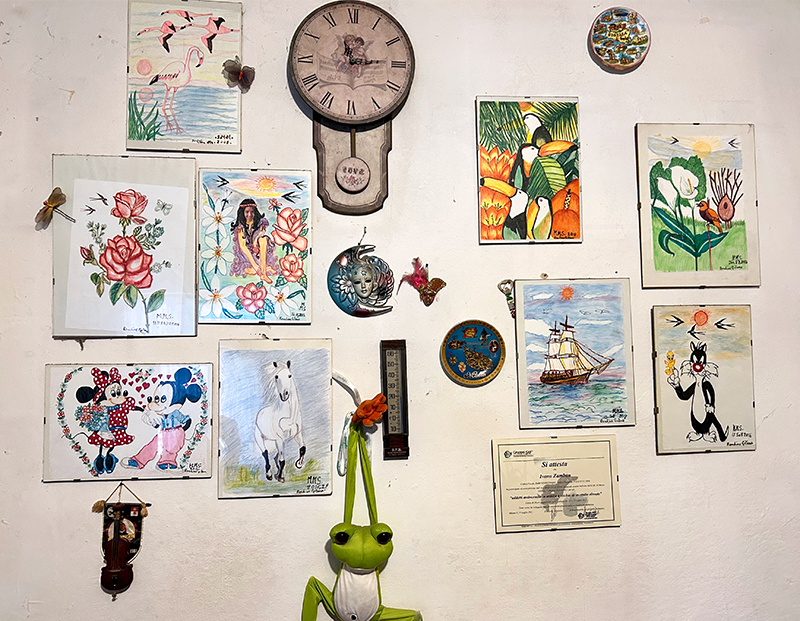
Esther Pearl Watson's father's drawings on the wall of his home.
So, you consider yourself growing up with a form of folk art and chose folk art as your language?
Yes, in a sense. I love the way that Anna Mary Robertson Moses, aka “Grandma Moses,” romanticizes and idealizes everything. I find it funny and cathartic when dealing with painful memories. The saucers in my paintings stand for hope in a hopeless situation. My paintings are like Ex Votos; they are about vision and hope. No matter how bad it gets, there is always a presence of salvation. The paintings are also about the American Dream, where you can be anything. My parents really believed that. My father really thought he could build a flying saucer.
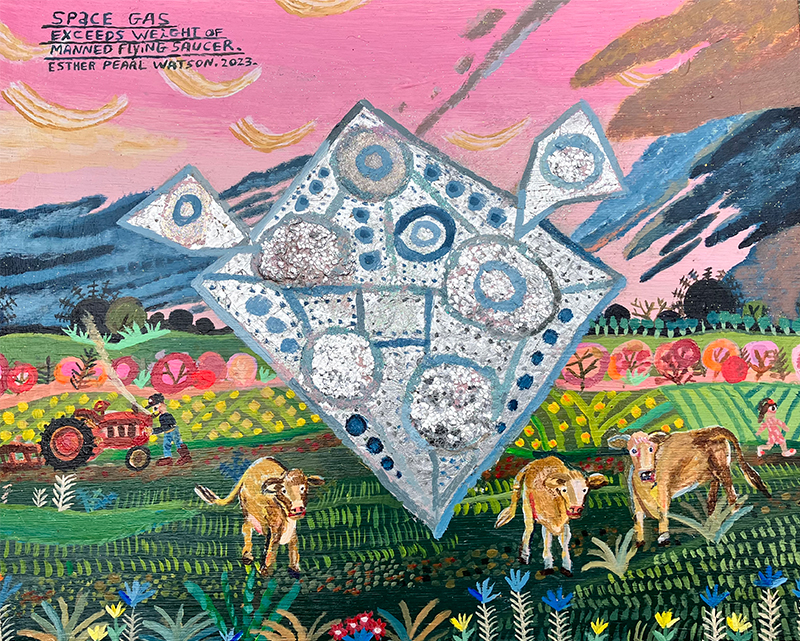
Esther Pearl Watson, Space Gas Exceeds Weight of Manned Flying Saucer, 2023.
The flying saucers in your paintings seem to be a trope for many different things, more a constant presence of something than a unique vision of some rare extraterrestrial being.
The flying saucers in the works are more of a symbol for the American Dream that my parents believed in, the hope that kept us as a family together, as well as the ever-present mental illness that was a fact in our daily lives. As kids in the late 80's, my siblings and I were outcasts, eccentric, punk kids; we were the weirdos. Kind of like aliens looming overhead. The story I’m always trying to tell is that of someone trying to fit in, like in my book Unlovable.
Unlovable is based on a diary of a 15-year-old girl that my husband and I found in a gas station. It’s a story about a girl who is trying to fit in and impress her friends. It’s the story of being 15, and in hindsight, you see all the things that you did wrong.
Ever since I was 13, I kept a diary, and to this day, I write in my diary every day. But in my diary, I pretended to be normal. I didn’t write about the flying saucers that sat parked in our front yard in my diary.

Esther Pearl Watson, I was left behind because I was not on their list, 2022
*Fun Esther Pearl Watson Fact:
Esther Pearl Watson remembers meeting Ionel Talpazan, another artist represented in SVMoA’s Sightings exhibition. She recalls seeing him in New York City selling his paintings and drawings lined up in front of the Metropolitan Museum of Art. In fact, she sent her father a postcard of one of his drawings of a flying saucer and recalls her father saying, “That flying saucer wouldn’t fly.” She regrets not buying one of his works.
Esther Pearl Watson’s recommended reading list:
- Her A-ha Moment: In Advance of the Landing: Folk Concepts of Outer Space, by Douglas Curran
- On the American Dream: Fantasyland: How America Went Haywire: A 500-year History, by Kurt Andersen
- On Being a Teenager: Unlovable, by Esther Pearl Watson
Tune in on Thu, Nov 9, 2023, at 6pm as Esther Pearl Watson takes SVMoA on a Virtual Studio Tour!
Join Sightings artist Esther Pearl Watson and SVMoA Curator Courtney Gilbert for a conversation about Watson’s “memory paintings” based on her childhood in Texas, where her father devoted himself to trying to build a working flying saucer, a tour of her studio, and a chat about what she’s working on now.
Free, Via Zoom
Thursday, November 9, 2023, 6 p.m.
CLICK HERE to join!